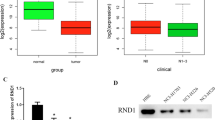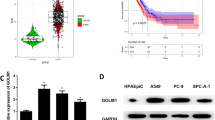Abstract
Previous research indicated that the dysregulation of miRNA-30a-5p has a correlation with cell metastasis of lung adenocarcinoma (LUAD). But the study about the molecular regulatory mechanism of miRNA-30a-5p in LUAD cell metastasis is limited. Thus, we discussed the mechanism of miRNA-30a-5p and its biological function in LUAD cells. By utilizing bioinformatics analysis, how miRNA-30a-5p was expressed in LUAD tissue was determined and its downstream target genes were predicted. The signaling pathways where these target genes enriched were analyzed. Several in vitro experiments were applied for cell function detection: dual-luciferase assay for validating the targeting relationship between miRNA-30a-5p and its target gene; quantitative real-time polymerase chain reaction for testing the expression of miRNA-30a-5p and its target gene in LUAD cells; MTT, transwell, cell adhesion, flow cytometry and immunofluorescence assays for examining the capabilities of LUAD cells to proliferate, migrate, invade, adhere, apoptosis and epithelial-mesenchymal transition (EMT) effect; Western blot for determining the expression of adhesion-related proteins and EMT-related proteins. Down-regulated miRNA-30a-5p was discovered in LUAD cells, but on the contrary, VCAN was upregulated. MiRNA-30a-5p overexpression notably repressed the virulent progression of LUAD cells. Besides, dual-luciferase assay validated the targeting relationship between miRNA-30a-5p and VCAN. MiRNA-30a-5p, by negatively regulating VCAN, was capable of hindering LUAD cell proliferation, migration, invasion, adhesion, viability and EMT. It was illustrated that miRNA-30a-5p could downregulate VCAN to retard the malignant progression of LUAD cells, which provides novel insights into LUAD pathogenesis, suggesting that miRNA-30a-5p/VCAN axis can be a promising anti-cancer target for LUAD.




Similar content being viewed by others
Data Availability
The datasets generated and analyzed during the current study are not publicly available, but are available from the corresponding author on reasonable request.
References
Jones, G. S., & Baldwin, D. R. (2018). Recent advances in the management of lung cancer. Clinical Medicine (London, England), 18, s41–s46. https://doi.org/10.7861/clinmedicine.18-2-s41
Chen, Z., Fillmore, C. M., Hammerman, P. S., Kim, C. F., & Wong, K. K. (2014). Non-small-cell lung cancers: A heterogeneous set of diseases. Nature Reviews Cancer, 14, 535–546. https://doi.org/10.1038/nrc3775
Wang, C., Wu, Y., Shao, J., Liu, D., & Li, W. (2020). Clinicopathological variables influencing overall survival, recurrence and post-recurrence survival in resected stage I non-small-cell lung cancer. BMC Cancer, 20, 150. https://doi.org/10.1186/s12885-020-6621-1
Chun, Y. S., et al. (2019). Deleterious effect of RAS and evolutionary high-risk TP53 double mutation in colorectal liver metastases. Annals of Surgery, 269, 917–923. https://doi.org/10.1097/SLA.0000000000002450
Erdogan, B., & Webb, D. J. (2017). Cancer-associated fibroblasts modulate growth factor signaling and extracellular matrix remodeling to regulate tumor metastasis. Biochemical Society Transactions, 45, 229–236. https://doi.org/10.1042/BST20160387
Le Noci, V., et al. (2018). Modulation of pulmonary microbiota by antibiotic or probiotic aerosol therapy: A strategy to promote immunosurveillance against lung metastases. Cell Reports, 24, 3528–3538. https://doi.org/10.1016/j.celrep.2018.08.090
Zeng, Y., et al. (2015). MUC1 predicts colorectal cancer metastasis: A systematic review and meta-analysis of case controlled studies. PLoS One, 10, e0138049. https://doi.org/10.1371/journal.pone.0138049
Ji, Z. H., Zhang, Y., & Li, Y. (2021). Intra-operative hyperthermic intraperitoneal chemotherapy for prevention and treatment of peritoneal metastases from gastric cancer: a narrative review. Journal Gastrointestinal Oncology, 12, S70–S78. https://doi.org/10.21037/jgo-20-262
Welter, S., Gupta, V., & Kyritsis, I. (2021). Lymphadenectomy in pulmonary metastasectomy. J Thorac Dis, 13, 2611–2617. https://doi.org/10.21037/jtd.2020.04.09
Hugenschmidt, H. et al (2021) Preoperative CTC-detection by CellSearch((R)) is associated with early distant metastasis and impaired survival in resected pancreatic cancer. Cancers (Basel), 13, 485. https://doi.org/10.3390/cancers13030485.
Zhang, D., et al. (2020). VCAM1 Promotes tumor cell invasion and metastasis by inducing EMT and transendothelial migration in colorectal cancer. Frontiers in Oncology, 10, 1066. https://doi.org/10.3389/fonc.2020.01066
Edwards, I. J. (2012). Proteoglycans in prostate cancer. Nature Reviews. Urology, 9, 196–206. https://doi.org/10.1038/nrurol.2012.19
Ricciardelli, C., Sakko, A. J., Ween, M. P., Russell, D. L., & Horsfall, D. J. (2009). The biological role and regulation of versican levels in cancer. Cancer and Metastasis Reviews, 28, 233–245. https://doi.org/10.1007/s10555-009-9182-y
Zhang, Q., et al. (2021). Upregulation of Versican associated with tumor progression, metastasis, and poor prognosis in bladder carcinoma. BioMed Research International, 2021, 6949864. https://doi.org/10.1155/2021/6949864
Zhang, Y., et al. (2019). Enhanced PAPSS2/VCAN sulfation axis is essential for snail-mediated breast cancer cell migration and metastasis. Cell Death and Differentiation, 26, 565–579. https://doi.org/10.1038/s41418-018-0147-y
Cen, S. Y., et al. (2020). A microRNA disease signature associated with lymph node metastasis of lung adenocarcinoma. Mathematical Biosciences and Engineering, 17, 2557–2568. https://doi.org/10.3934/mbe.2020140
Jing, P., et al. (2020). miR-24-3p/KLF8 Signaling axis contributes to LUAD metastasis by regulating EMT. Journal of Immunology Research, 2020, 4036047. https://doi.org/10.1155/2020/4036047
Sun, L., et al. (2019). miR-302a inhibits metastasis and cetuximab resistance in colorectal cancer by targeting NFIB and CD44. Theranostics, 9, 8409–8425. https://doi.org/10.7150/thno.36605
Li, Q., et al. (2018). Exosomal miR-21-5p derived from gastric cancer promotes peritoneal metastasis via mesothelial-to-mesenchymal transition. Cell Death & Disease, 9, 854. https://doi.org/10.1038/s41419-018-0928-8
Ren, L., et al. (2019). MiR-454-3p-mediated Wnt/beta-catenin signaling antagonists suppression promotes breast cancer metastasis. Theranostics, 9, 449–465. https://doi.org/10.7150/thno.29055
Chen, C., Tang, J., Xu, S., Zhang, W., & Jiang, H. (2020). miR-30a-5p inhibits proliferation and migration of lung squamous cell carcinoma cells by targeting FOXD1. BioMed Research International, 2020, 2547902. https://doi.org/10.1155/2020/2547902
Wu, W., et al. (2020). LncRNA DLEU2 accelerates the tumorigenesis and invasion of non-small cell lung cancer by sponging miR-30a-5p. Journal of Cellular and Molecular Medicine, 24, 441–450. https://doi.org/10.1111/jcmm.14749
Xiong, J., Wei, B., Ye, Q., & Liu, W. (2019). MiR-30a-5p/UBE3C axis regulates breast cancer cell proliferation and migration. Biochemical and Biophysical Research Communications, 516, 1013–1018. https://doi.org/10.1016/j.bbrc.2016.03.069
Huang, X., Wang, L., Liu, W., & Li, F. (2019). MicroRNA-497-5p inhibits proliferation and invasion of non-small cell lung cancer by regulating FGF2. Oncology Letters, 17, 3425–3431. https://doi.org/10.3892/ol.2019.9954
Wan, J., & Wu, W. (2016). Hyperthermia induced HIF-1a expression of lung cancer through AKT and ERK signaling pathways. Journal of Experimental & Clinical Cancer Research, 35, 119. https://doi.org/10.1186/s13046-016-0399-7
Chen, S., et al. (2021). Forkhead box D1 promotes EMT and chemoresistance by upregulating lncRNA CYTOR in oral squamous cell carcinoma. Cancer Letters, 503, 43–53. https://doi.org/10.1016/j.canlet.2020.11.046
Fu, Q., et al. (2018). Primary tumor-derived exosomes facilitate metastasis by regulating adhesion of circulating tumor cells via SMAD3 in liver cancer. Oncogene, 37, 6105–6118. https://doi.org/10.1038/s41388-018-0391-0
Deng, F., Xu, Z., Zhou, J., Zhang, R., & Gong, X. (2021). ANLN regulated by miR-30a-5p mediates malignant progression of lung adenocarcinoma. Computational and Mathematical Methods in Medicine, 2021, 9549287. https://doi.org/10.1155/2021/9549287
Zhang, Y., & Li, Y. (2020). Long non-coding RNA NORAD contributes to the proliferation, invasion and EMT progression of prostate cancer via the miR-30a-5p/RAB11A/WNT/beta-catenin pathway. Cancer Cell International, 20, 571. https://doi.org/10.1186/s12935-020-01665-2
Savagner, P. (2010). The epithelial-mesenchymal transition (EMT) phenomenon. Annals of Oncology, 21(7), vii89-92.
Chen, T., You, Y., Jiang, H., & Wang, Z. Z. (2017). Epithelial-mesenchymal transition (EMT): A biological process in the development, stem cell differentiation, and tumorigenesis. Journal of Cellular Physiology, 232, 3261–3272. https://doi.org/10.1002/jcp.25797
Wang, L., Zhao, S., & Yu, M. (2019). Mechanism of low expression of miR-30a-5p on epithelial-mesenchymal transition and metastasis in ovarian cancer. DNA and Cell Biology, 38, 341–351. https://doi.org/10.1089/dna.2018.4396
Chen, S., et al. (2021). miR-30a-5p regulates viability, migration, and invasion of lung adenocarcinoma cells via targeting ECT2. Computational and Mathematical Methods in Medicine, 2021, 6241469. https://doi.org/10.1155/2021/6241469
Zhang, Z., et al. (2020). The miR-30a-5p/CLCF1 axis regulates sorafenib resistance and aerobic glycolysis in hepatocellular carcinoma. Cell Death & Disease, 11, 902. https://doi.org/10.1038/s41419-020-03123-3
Tao, K., et al. (2021). Vascular endothelial cell-derived exosomal miR-30a-5p inhibits lung adenocarcinoma malignant progression by targeting CCNE2. Carcinogenesis, 42, 1056–1067. https://doi.org/10.1093/carcin/bgab051
Li, W., Han, F., Fu, M., & Wang, Z. (2020). High expression of VCAN is an independent predictor of poor prognosis in gastric cancer. Journal of International Medical Research, 48, 300060519891271. https://doi.org/10.1177/0300060519891271
Cheng, Y., et al. (2020). VUp-regulation of VCAN promotes the proliferation, invasion and migration and serves as a biomarker in gastric cancer. Oncotargets and Therapy, 13, 8665–8675. https://doi.org/10.2147/OTT.S262613
Mitsui, Y., et al. (2017). Versican promotes tumor progression, metastasis and predicts poor prognosis in renal carcinoma. Molecular Cancer Research, 15, 884–895. https://doi.org/10.1158/1541-7786.MCR-16-0444
Li, R., Hou, S., Zou, M., Ye, K., & Xiang, L. (2021). miR-543 impairs cell proliferation, migration, and invasion in breast cancer by suppressing VCAN. Biochemical and Biophysical Research Communications, 570, 191–198. https://doi.org/10.1016/j.bbrc.2021.07.005
Zhao, X., et al. (2017). MiR-135a-5p modulates biological functions of thyroid carcinoma cells via targeting VCAN 3’-UTR. Cancer Biomarkers, 20, 207–216. https://doi.org/10.3233/CBM-170566
Xiang, J., Bian, C., Wang, H., Huang, S., & Wu, D. (2015). MiR-203 down-regulates Rap1A and suppresses cell proliferation, adhesion and invasion in prostate cancer. Journal of Experimental & Clinical Cancer Research, 34, 8. https://doi.org/10.1186/s13046-015-0125-x
Minn, A. J., et al. (2005). Genes that mediate breast cancer metastasis to lung. Nature, 436, 518–524. https://doi.org/10.1038/nature03799
Reina, M. & Espel, E (2017) Role of LFA-1 and ICAM-1 in cancer. Cancers (Basel), 9, 153. https://doi.org/10.3390/cancers9110153.
Funding
This study was supported in part by grants from Health Science and Technology Project of Zhejiang Province – General Project(2021KY1152).
Author information
Authors and Affiliations
Contributions
E.Q. participated in the design and interpretation of the data and drafting/revising the manuscript. G.M.P and S.J.G conceived of the study, and participated in its design and interpretation and helped to draft the manuscript. Y.M.G performed the statistical analysis and revised the manuscript critically. L.Y.W participated in its design and interpretation and helped to revise the manuscript critically.
All the authors read and approved the final manuscript.
Corresponding author
Ethics declarations
Conflict of Interest
The authors declare no competing interests.
Additional information
Publisher's Note
Springer Nature remains neutral with regard to jurisdictional claims in published maps and institutional affiliations.
Rights and permissions
Springer Nature or its licensor (e.g. a society or other partner) holds exclusive rights to this article under a publishing agreement with the author(s) or other rightsholder(s); author self-archiving of the accepted manuscript version of this article is solely governed by the terms of such publishing agreement and applicable law.
About this article
Cite this article
Qin, E., Gu, S., Guo, Y. et al. MiRNA-30a-5p/VCAN Arrests Tumor Metastasis via Modulating the Adhesion of Lung Adenocarcinoma Cells. Appl Biochem Biotechnol 195, 7568–7582 (2023). https://doi.org/10.1007/s12010-023-04444-7
Accepted:
Published:
Issue Date:
DOI: https://doi.org/10.1007/s12010-023-04444-7




